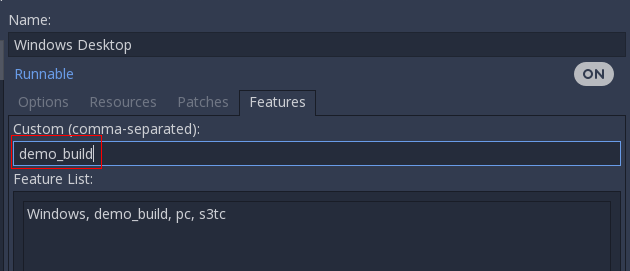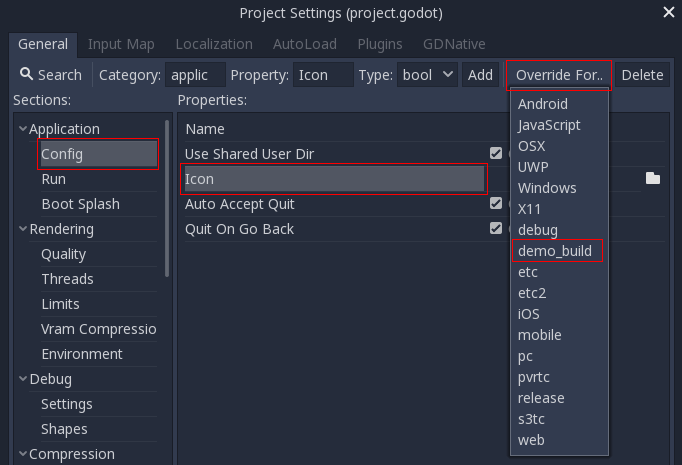Feature tags¶
Introduction¶
Godot has a special system to tag availability of features. Each feature is represented as a string, which can refer to many of the following:
- Platform name.
- Platform architecture (64-bit or 32-bit, x86 or ARM).
- Platform type (desktop, mobile, Web).
- Supported texture compression algorithms on the platform.
- Whether a build is
debugorrelease(debugincludes the editor). - Whether the project is running from the editor or a “standalone” binary.
- Many more things.
Features can be queried at run-time from the singleton API by calling:
OS.has_feature(name)
Default features¶
Here is a list of most feature tags in Godot. Keep in mind they are case-sensitive:
| Feature tag | Description |
|---|---|
| Android | Running on Android |
| HTML5 | Running on HTML5 |
| JavaScript | JavaScript singleton is available |
| OSX | Running on macOS |
| iOS | Running on iOS |
| UWP | Running on UWP |
| Windows | Running on Windows |
| X11 | Running on X11 (Linux/BSD desktop) |
| Server | Running on the headless server platform |
| debug | Running on a debug build (including the editor) |
| release | Running on a release build |
| editor | Running on an editor build |
| standalone | Running on a non-editor build |
| 64 | Running on a 64-bit build (any architecture) |
| 32 | Running on a 32-bit build (any architecture) |
| x86_64 | Running on a 64-bit x86 build |
| x86 | Running on a 32-bit x86 build |
| arm64 | Running on a 64-bit ARM build |
| arm | Running on a 32-bit ARM build |
| mobile | Host OS is a mobile platform |
| pc | Host OS is a PC platform (desktop/laptop) |
| web | Host OS is a Web browser |
| etc | Textures using ETC1 compression are supported |
| etc2 | Textures using ETC2 compression are supported |
| s3tc | Textures using S3TC (DXT/BC) compression are supported |
| pvrtc | Textures using PVRTC compression are supported |
Custom features¶
It is possible to add custom features to a build; use the relevant field in the export preset used to generate it:

Overriding project settings¶
Features can be used to override specific configuration values in the Project Settings. This allows you to better customize any configuration when doing a build.
In the following example, a different icon is added for the demo build of the game (which was customized in a special export preset, which, in turn, includes only demo levels).

After overriding, a new field is added for this specific configuration:

Default overrides¶
There are already a lot of settings that come with overrides by default; they can be found in many sections of the project settings.

Customizing the build¶
Feature tags can be used to customize a build process too, by writing a custom ExportPlugin. They are also used to specify which shared library is loaded and exported in GDNative.